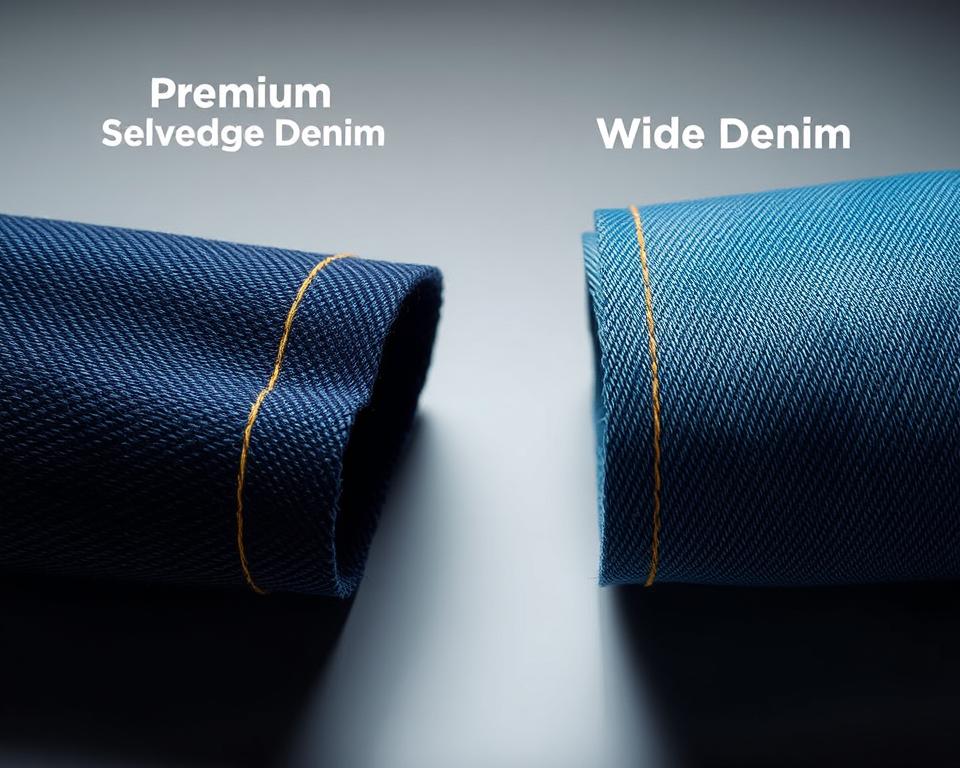Your Manual for Superior denim Edge-to-Edge Fabric
Ever pondered why some pants seem like they’re built for endurance a lifetime? The secret lies in the materials and craftsmanship. Take, for instance, the rising trend of high-end selvedge. This isn’t just any material—it’s a testament to quality and legacy.
Nowadays, more people are turning to these classic fabrics for their robustness and traditional selvedge denim fabric charm. Whether you’re a do-it-yourself sewist or a denim lover, there’s an exceptional aspect about using superior natural fiber and thread. It’s not just about creating pants; it’s about crafting a narrative.
Within Core Fabrics, we’ve assembled a range of 14.25oz organic cotton and flexible options. These materials are ideal for all from raw jeans to couture jacket designs. Eager to discover the universe of premium fabrics? Let’s jump right in.
Defining Denim Selvedge Fabric?
What makes particular trousers set themselves apart with their signature, finished without extra steps borders? The secret is found in the selvedge denim, a high-quality fabric renowned for its robustness and retro charm. Unlike regular textiles, such material is fashioned using time-honored methods that have endured through ages.
The Definition of Selvedge Denim
Selvedge denim is manufactured via old-style shuttle looms, which yield minimal widths of about 30-35 inches. They intertwine the fabric in a manner that ensures self-finished seams, often highlighted by a signature red line. This process ensures the material is firmly crafted and exceptionally sturdy.
Current looms, alternatively, generate broader textile but do not offer the same level of skill. The imperfections in selvedge, like twists in the leg or irregular surfaces, are celebrated as elements of its beauty. This philosophy, known as “wabi-sabi”, honors the appeal of natural flaws.
How Selvedge Denim Is Made
The manufacturing of selvedge denim involves a meticulous process. These looms interlace the filling yarns in alternating directions, resulting in a dense and resilient fabric. This process stands in contrast with contemporary machines, which focus on speed and efficiency over craftsmanship.
Companies such as Karson Denim maintain time-honored Japanese craft practices from the nineteen-nineties. They intentionally include imperfections to maintain the authenticity of the textile. Every item is evaluated on a 4-point system, guaranteeing it meets the highest standards of superiority.
| Feature | Selvedge Denim | Current Denim |
|---|---|---|
| Width | 30-35 inches | 60+ inches |
| Weaving Process | Classic Shuttle Loom | Contemporary Loom |
| Surface | Uneven, Imperfect | Consistent |
| Durability | Exceptional | Standard |
“The charm of selvedge is found in its flaws—each irregularity speaks of craftsmanship and tradition.”
The Background of Selvedge Denim
Evolving from simple roots to worldwide renown, the story of these textiles is vibrant and inspiring. Originally developed as durable workwear in 17th-century France evolved into a signifier of everlasting fashion and artistry.
Origins in Traditional Weaving
The foundation of this fabric reaches back to Nîmes, France, where it was dubbed “serge de Nîmes.” Initially created for laborers, it was crafted out of robust cotton and yarn. Its durability made it a favorite among the workforce during the historic Gold Rush.
By the 20th century, it had become a cornerstone for trousers. The shuttering of the Cone Mills White Oak plant became a pivotal moment. This shift enabled Japanese craftsmen to reintroduce classic fabric-making practices.

Evolution in Modern Denim Production
Post-WWII, Japan adopted old-school American culture. Craftsmen revitalized classic looms to create genuine reproductions. This devotion to quality ensured the survival of selvedge as a niche product.
Today, advancements from Italy and Turkey have launched eco-friendly mixtures and stretch selections. These improvements have enhanced the appeal of this timeless fabric. At Core Fabrics, we procure internationally, from Montréal to Asia, to offer you the finest excellence.
“The legacy of selvedge is a tribute to the lasting worth of craftsmanship and legacy.”
Reasons to Select Selvedge Denim?
What makes selvedge denim distinguish itself in the world of premium fabrics? Its distinct attributes and incomparable robustness render it popular among enthusiasts and creatives alike. Whether you’re sewing pants or a structured jacket, this textile delivers a fusion of classic methods and updated style.
Distinctive Attributes of Selvedge
Selvedge denim is known for its tight weave, which boosts tear resistance and color fading characteristics. Differing from regular textiles, selvedge denim material is crafted using classic shuttle looms, yielding a more compact and exceptionally sturdy product. In doing so, it secures that each piece has a unique texture and individuality.
Here’s what makes it special:
- Textured, firm raw denim offers a contrast to softened, pre-washed stretch fabrics.
- The sanforization process ensures predictable sizing, while raw options offer a unique shrinkage journey.
- Available weights span from 9.5oz Eco Finish to 14.25oz Organic, suited for diverse applications.
Robustness and Endurance
One of the standout features of selvedge denim is its longevity. The firm interlacing both reinforces strength and permits characteristic wear patterns over time. This renders it a wise purchase for those looking for classic garments.
Main considerations:
- Mid-weight fabrics from 12oz to 14oz work well for tailored jackets and evolving jeans.
- Opt for the 14.25oz True Indigo for traditional jean lifespan.
- Sustainable variants such as recycled cotton combined with indigo blends enhance eco-friendliness.
Core Fabrics offers an assortment of products tailored for every requirement. Spanning from raw finishes to sanforized treatments, each selection is designed for superior quality and value.
Selvedge vs. Wide Denim: A Comparison
In the creation of robust and fashionable apparel, the decision of fabric is pivotal. Two popular options are selvedge and wide denim, both offering different features. Comprehending their variances guides the ideal material for your project.
Contrasting Weave Techniques
Selvedge denim is produced using time-honored shuttle looms, producing narrow widths of 30-35 inches. This herringbone denim material technique generates firm borders, often marked by a distinctive red line. In contrast, wide denim is produced using modern projectile looms, yielding widths of 60 inches or more.
Old-style shuttle looms yield roughly 3m per minute, while projectile looms can produce up to 30 meters per minute. The variance in production speed affects both the cost and the finish of the outcome.
Advantages and Disadvantages
Selvedge denim is renowned for its high-end construction and robustness. Its slender dimension suits it well for creations where defined edges and detail work are sought. However, it can be more expensive, generally priced at $23 per meter.
Wide denim is economical, ranging at $8 per half-meter. Its expansive dimension reduces waste, well-suited to big-scale works like furniture covering. However, it falls short of the signature finished border of selvedge.
| Attribute | Selvedge Denim | Wide Denim |
|---|---|---|
| Measurement | 30-35 inches | 60+ inches |
| Technique | Shuttle Loom | Projectile Loom |
| Rate | 3m per minute | 30 meters per minute |
| Cost | $23/meter | $8/half-meter |
For defined borders as seen in Grainline Thayer jackets, selvedge is favored. For larger projects, wide denim offers better value and efficiency. Weigh your requirements carefully to decide.
How to Use Selvedge Denim
Utilizing superior fabrics can transform your sewing endeavors. Whether you are creating jeans, outerwear, or dresses, grasping fabric quantities, proper sewing methods, and maintenance guarantees a polished result. Let’s explore how to make the most of this everlasting textile.
Fabric Quantities for Your Projects
When planning your project, calculating the right amount of material is crucial. Approximately 3-3.3 yards is necessary for men’s jeans, considering defects and shrinkage. For trucker jackets, expect to use around 3.3 yards, while skirts require only 2 yards.
Smart pattern positioning minimizes the impact of defects. Embrace the natural defects by weaving them into your creative design.
| Item | Required Yardage |
|---|---|
| Jeans for Men | 3 to 3.3 yards |
| Trucker Jacket | 3.3 yards |
| Skirt Item | 2 yards |
Sewing Techniques and Maintenance
Employing proper equipment and methods leads to an impeccable finish. Opt for #70–110 needles and machine attachments made for robust textiles. Gütermann rPET thread works well for contrasting stitches.
Here are some additional tips:
- Employ a tailor’s clapper to achieve crisp creases without gloss.
- Core Fabrics’ denim kits include topstitch thread, rivets, and 9mm jeans buttons for a professional finish.
- For structured edges, like those in jackets, selvedge is the preferred choice.
Maintaining your pieces properly increases their longevity. Use minimal washing and opt for air drying to preserve fabric quality. Adhering to these practices will sustain your creations for years.
Wrapping It Up
Crafting with premium materials isn’t just about durability—it’s about creating something with character. Selvedge denim exemplifies this ideology, merging craftsman allure with robust strength. Whether you’re sewing jeans or a structured jacket, this material tells a story with every stitch.
Core Fabrics simplifies your creative journey. Our swatch service lets you touch and test the fabric before deciding. Additionally, benefit from complimentary shipping on orders exceeding $150 USD throughout North America.
Looking ahead, eco-friendly blends and vintage washes are shaping the future of cotton textiles. These trends offer new ways to add sustainability and style to your wardrobe.
Eager to explore top-tier textiles? Shop now and discover the value of crafting with purpose. Your next project could be a timeless piece that lasts for years to come.

